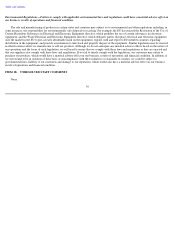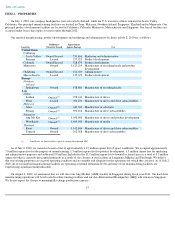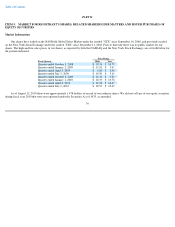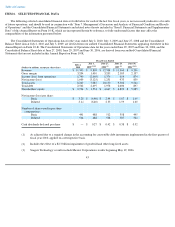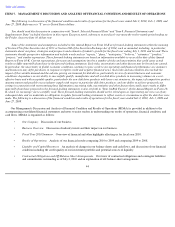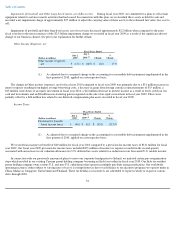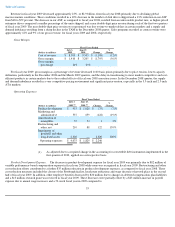Seagate 2009 Annual Report Download - page 48
Download and view the complete annual report
Please find page 48 of the 2009 Seagate annual report below. You can navigate through the pages in the report by either clicking on the pages listed below, or by using the keyword search tool below to find specific information within the annual report.
Table of Contents
include storage for cloud computing and backup services, will continue to grow and drive demand for disk drives designed with these attributes
as data centers expand and proliferate.
We believe that the enterprise storage TAM increased 21%, as compared to the prior fiscal year, due to the deferral of information
technology equipment purchases experienced in fiscal year 2009, when storage utilization rates of existing disk drives in data centers increased.
SSD storage applications have been introduced as a potential alternative to redundant system startup or boot disk drives. In addition,
enterprises are beginning to use SSDs in applications where rapid processing and/or lower power consumption is required. The timing of
significant adoption of SSDs is dependent on enterprises weighing the pricing and other benefits of mission critical enterprise disk drives against
the perceived performance benefits of SSDs.
Disk Drives for Client Compute. We define client compute applications as disk drives designed for the traditional desktop and mobile
compute applications. In the near-
term, we believe that demand growth in client compute applications will be driven by what we believe to be an
accelerating corporate technology refresh cycle. In the long-
term, we believe that the proliferation of digital content will drive the demand for the
client compute market. We believe that the client compute storage TAM increased 24% as compared to the prior fiscal year mainly due to the
strength in consumer spending for technology for most of the 2010 fiscal year.
As the proliferation of client compute applications that require minimal storage such as tablets and netbooks continues, NAND flash
technology could become more competitive within the client compute market in the future.
Disk Drives for Client Non-Compute. We define client non-compute applications as disk drives designed for consumer electronic devices
and disk drives used for external and network-attached storage (NAS). Disk drives designed for consumer electronic devices are primarily used
in applications such as DVRs that require a higher capacity, lower cost-per-gigabyte storage solution. Disk drives for external and NAS devices
are designed for purposes such as personal data backup, portable external storage and to augment the consumer's current desktop, notebook or
DVR disk drive capacities. Client non-compute applications also include devices designed to display digital media in the home theater. We
believe the proliferation of high definition and media-rich digital content will continue to create increasing consumer demand for higher storage
solutions, as evidenced by an increase in the client non-compute TAM of 14%, as compared to the prior fiscal year.
Product Life Cycles and Changing Technology
Our industry has been characterized by significant advances in technology, which have contributed to rapid product life cycles. As a result,
success in our industry has been dependent to a large extent on the ability to be the first-to-market with new products, allowing those disk drive
manufacturers who introduce new products first to sell those products at a premium until comparable products are introduced. Also, because our
industry is characterized by continuous price erosion, the existence of rapid product life cycles has necessitated quick achievement of product
cost effectiveness. Changing technology also necessitates on-going investments in research and development, which may be difficult to recover
due to rapid product life cycles and economic declines. Further, there is a continued need to successfully execute product transitions and new
product introductions, as factors such as quality, reliability and manufacturing yields become of increasing competitive importance.
Price Erosion
Our industry has been characterized by price declines for disk drive products with comparable capacity, performance and feature sets ("like-
for-like products"). Price declines for like-for-like products ("price erosion") are more pronounced during periods of:
•
economic contraction or industry consolidation in which competitors may use discounted pricing to attempt to maintain or gain
market share;
46


